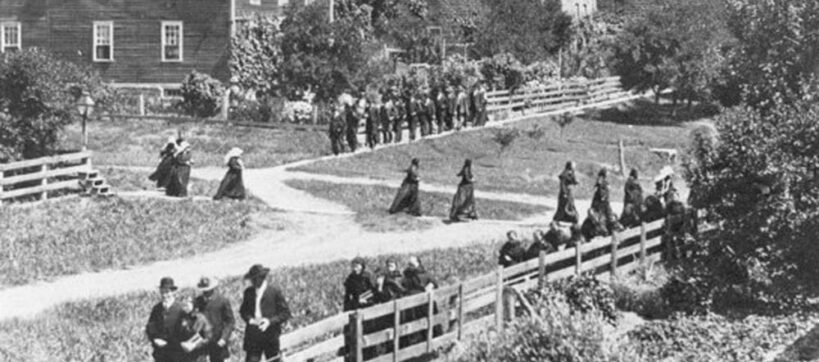Blog
Timeless Love; Weddings in Communal Amana

Life in communal Amana was as well-regulated as the clock on the wall in the Amana railroad depot, but love, never routine, and always disruptive, happened and young people met and married in the villages of old Amana just as they did elsewhere, but in Amana between 1855-1932 there were rules that made weddings and wedding celebrations anything but routine.
Amana, created as a haven where men and women might serve the Lord, did not emphasize marriage. Indeed until about 90 years ago, celibacy was encouraged for both men and women. An 1839 "statement of faith" written and distributed in Germany by the Inspirationists deals with celibacy and marriage this way, "We believe that marriage is ordained by God and therefore its practice continued among us.... Yet we also value the instructions of the Holy Apostle Paul who repeated the attestation, "Marriage is good, but to remain unmarried is better."
Remaining single was an option with no stigma attached. Likewise there was no economic incentive to marry. Jobs and housing were provided by the community. A single woman need never worry about her future home. Likewise, a young man need never consider finding a wife with property. Hence about 25% of the adult population remained unmarried.
With no social or economic pressure to marry, young Amana women and men were free to marry for love. Who chose whom was left to the young people, though of course one's parents and grandparents advised. Courting was expected to last for years, and dates, always chaperoned, might consist of long walks, buggy rides, sledding, ice skating and group gatherings. Dances and balls were unheard of in old Amana.
The council of Elders approved marriages and only when couples were of age could they ask for permission to marry. The marriage age in the Colonies did vary over the decades but generally it was age 21 for women and 25 for men. By the time a couple approached the Elders asking permission to marry, they had been courting for at least two years and had there been objections to the match, the Elders would have approached the couple long before. Once permission was given, the Elders set the wedding date – always a year hence. Yes, engaged couples were asked to wait one year to "make certain." The groom was then sent to another village or at least further afield to allow everyone time to reflect and to remove temptation, so to speak. No wedding was impulsive in communal Amana.
Wedding ceremonies were generally held on Thursdays in the summer and only the bride and groom's extended family accompanied them to the church for the ceremony. The bride dressed in black as per usual, but she wore her very best black lace trimmed cap, fine black lawn or black sateen apron and shawl. White wedding gowns and veils were not worn in Amana until Oct. 23, 1948 when bride Mary Ann Haas became Mrs. George Fels in the Amana Church wearing a white, satin gown and white lace veil. Her bouquet of mums and her pretty bridesmaids were also firsts in the Amana colonies.
In communal Amana following a simple worship ceremony (during which the couple shook hands with the Elder. No kiss was exchanged after the couple affirmed their intent to live as husband and wife in the sight of God) the Elder, the couple and their families went to the kitchen house for dinner. Often this was the bride's own kitchen house or that of a close relative. Her friends prepared and served the meal which traditionally consisted of smoked ham, soup, salads, and "marbled Sternkuchen" (a chocolate, vanilla and almond flavored marble cake baked in the shape of a star). The ladies decorated the dining room with fresh cut flowers, sprays of leafy lilies and ivy or houseplants and potted flowers.
Afterward a much larger and even merrier celebration was held in the lawn of the groom's family home or that of a relative living in the bride's village (if the couple did not live in the same village). Preparations for this party mostly involved borrowing glasses, dishes and cutlery from the kitchen houses, hauling garden benches from all the neighbor's yards, making and bottling plenty, yes plenty, of home-brew beer and rootbeer. The most crucial task – asking your favorite uncle for a barrel of his best rhubarb wine. All of these tasks the groom and his friends undertook. The groom even delivered the hand written invitations to the celebration himself. Of course his delivery of the invitation usually meant he was invited to stay for a glass of celebratory wine and a toast to the young couple's happiness so it wasn't exactly a burdensome chore.
Friends and family would bring cake to the reception and it was not uncommon for a wedding celebration to feature 60 or more cakes all of which were arranged buffet style on large trestle tables under the grape arbor, making a fine display of sugary goodness. Typically about 200 or more guests attended this event which usually involved lots of laughter, choral singing and German recitations. Guests brought only very small gifts or homemade keepsakes; a walnut "whatnot shelf", embroidered pillowcases, wall hangings, a pretty vase and so forth.
After the celebration, everyone, including the bride and groom bid a fond farewell to one another and headed home. It was customary in the pre-1932 Colony for the bridal couple not to move in together until a few days after the ceremony. Why? Well, as their parents explained, "just to give everyone time to get used to the idea."
From the "Willkommen" late summer 2018, written by Emilie Hoppe - used with permission.

